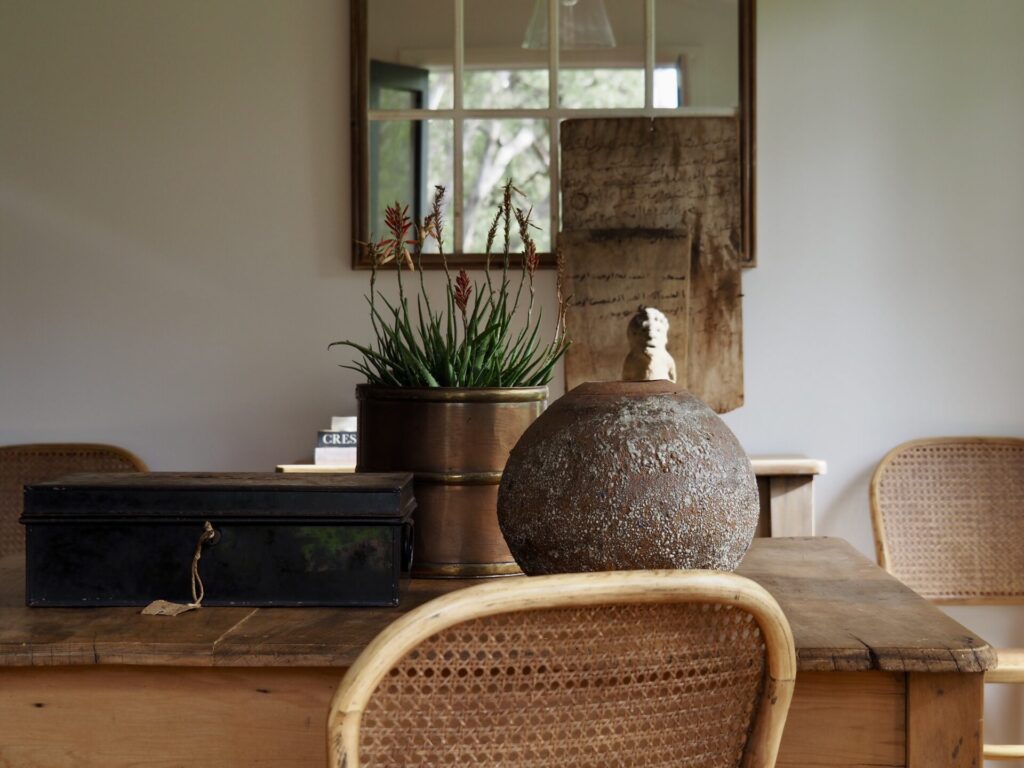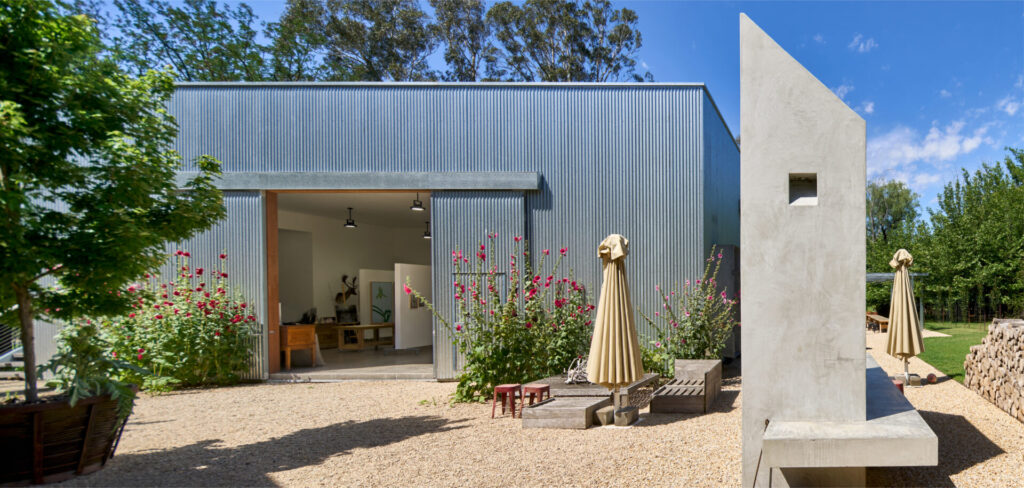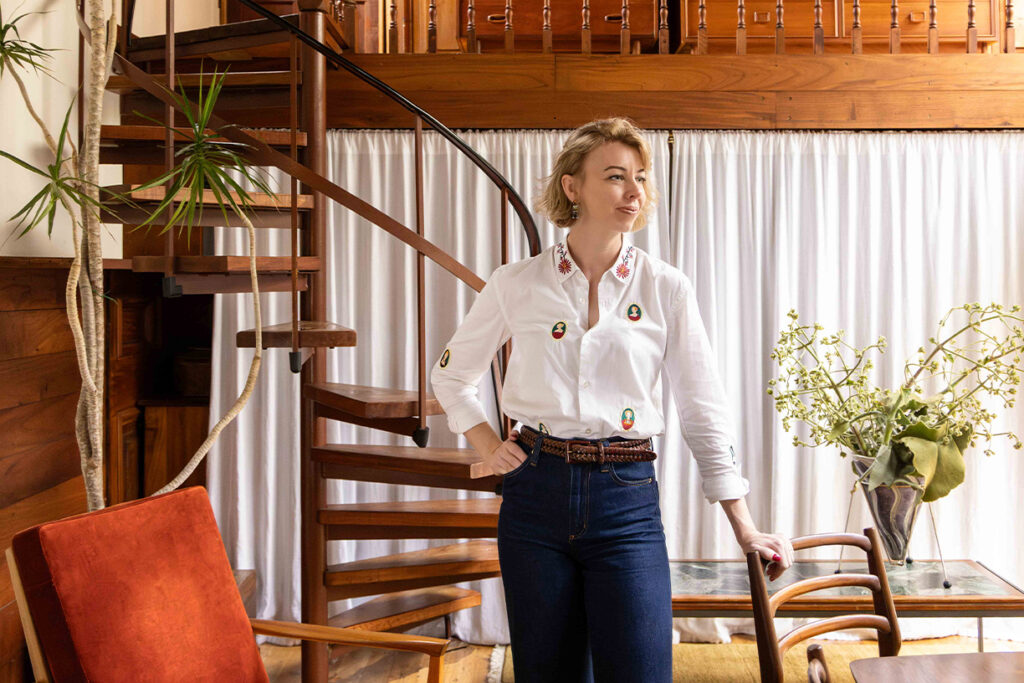The Business of Gardening by Michael Reid OAM
To celebrate spring’s arrival – and the publication of a beautiful garden story in the August issue of Australian House & Garden – Michael Reid OAM walks us through the idyllic grounds that envelop the gallery, concept store and kiosk at Michael Reid Murrurundi and seed the inspiration for a flourishing creative business.
An understanding of gardening makes for good business, and my art gallery business at Murrurundi, in turn, informs the design and role of my garden. But to begin with, what is gardening? For me, gardening is the experience of an emotion made physical. Formal parterre-style gardens are designed to reveal their majesty through an all-in-one, almost architectural viewing sweep—their symmetry, their topiary, their scale of precise awe. Emotionally, formal gardens aspire to reverence.
My emotional horticultural go-to word is ‘drowsy’. Not informal or unkempt, far from it, but certainly not overly clipped or ruthlessly symmetrical. In my garden’s climate at Murrurundi in the Upper Hunter of New South Wales, no plant has ever died from lack of mowing or hedging, yet all things wither for lack of water. I lean toward a soft, well-watered, relaxed garden, one that slowly wakes with a walk-through reveal.


Gardening keeps me occupied without overtly engaging with people, and that is generally best for everyone. I like to tinker and think, after all, weeding is simply a remodelling through removal. I would love to own a Bobcat. To be frank, I am not so much of a gardener as a designer. I will point out the weeds; I rarely pull them out. I find profound joy in my garden coming together—its intention or purpose, the plants used to this end or that, their health, and growth. The season. The light. The rain. I have an understanding to my bones of how the English word for Paradise derives its root from the Persian word for a walled garden. A garden is an earthly delight. A garden is Eden.
It is unsurprising that the land was our species’ first industry. Initially, we organised through hunting the animals that moved across the land, and then we cultivated land to create food certainty—cultivating growth. Seeding ideas. Bearing fruit. Fertile ground. Cross-pollinating. Cultivating relationships. Green thumb. Blossoming. A thorny issue. Cutting back or pruning ‘deadwood’ are all land-use terms that thrive within our understanding of business. It is hardly surprising, then, that one of the most feared corporate arborists in this country’s history, the infamous downsizer, was nicknamed ‘Chainsaw’ Al Dunlap. Business gets gardening and the tools of gardening, and I would argue that an understanding of gardening makes for good business. You have an idea. Within your understanding and growing knowledge—for you always learn with gardening–you devise and plan and give things a studied go. You are persistent in wanting to make your ideas and plans work, and if they don’t, you begin again. You redesign and change from root to branch, taking all back to dirt in a need to pivot and salvage.
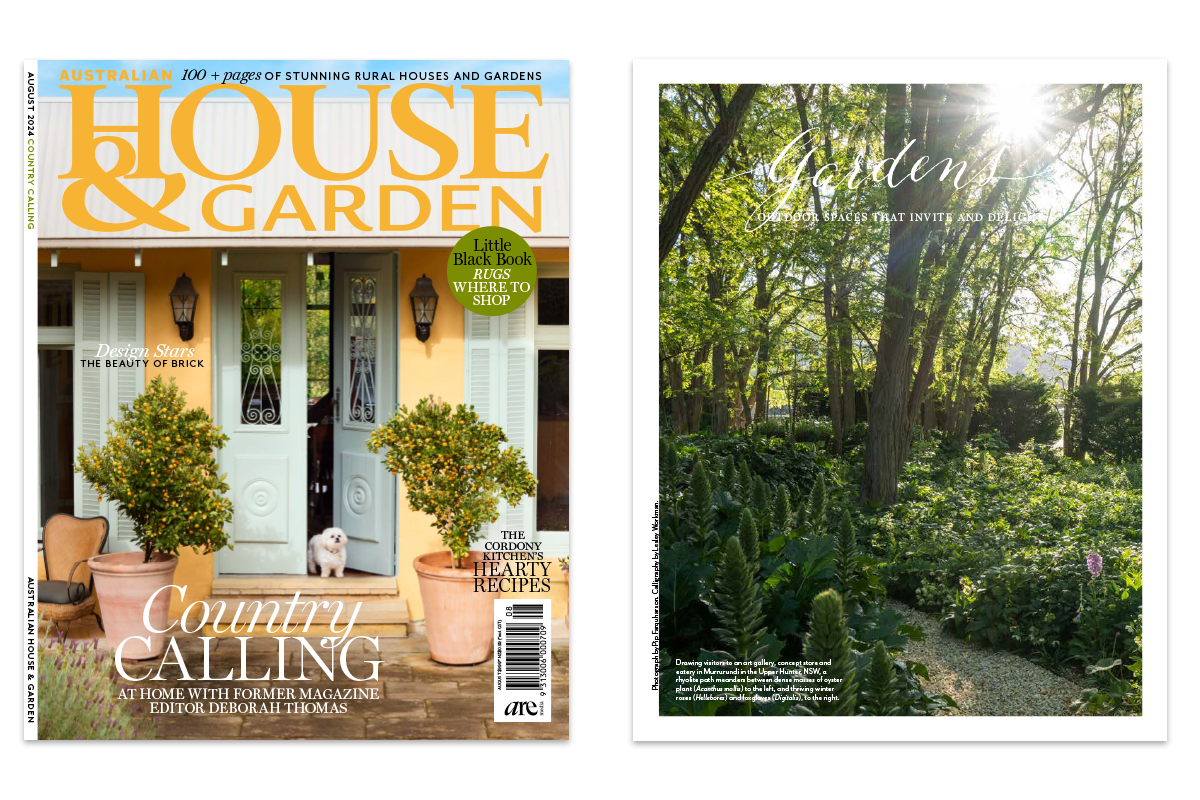

Like a garden, a business does not endure through an over-concentration on established trophy plantings. Even the oldest and sturdiest of oak trees eventually die, and it may surprise many to learn that our national floral emblem, the Golden Wattle tree, has a life expectancy of just over a decade. Beautiful, important, and established gardens are always planting anew and replanting the old. A centrepiece of my gallery’s 2024 Strategy Paper, a yearly document that reviews what has come before and charts our intended directional growth for the coming 12 months—from the tips of our many branches to our well-established roots—was to further develop the Murrurundi Garden.





The gallery, Concept Store, and Kiosk at Murrurundi are destinational retail; the entire purpose of this creative space is to entice our audience to visit, slow down, enjoy the garden, eat and drink well, and view and acquire nationally significant art. The garden is both an aesthetic and commercial drawcard. It is within beauty that one can best absorb the beauty, enjoyment, and value on offer. To enter the gallery garden, you walk a Rhyolite gravel path. A meandering path, that wends its way through beds of Oyster plants (Acanthus mollis), winter roses (Hellebores) and May bush (Spiraea). I mass plant. Down the garden path you approach the monumental new structure of the art gallery, nestled a distance from the Concept Store, a former colonial cell block converted into a buggy stable in the 1890s. The garden is designed to draw people across the Murrurundi spaces. My outside cantilevered fireplace is designed to create a “wow” moment and bookend the gravelled central courtyard. The fireplace acts as a monumental Donald Judd style sculpture. From the central outdoor space, overflowing with Anatolian Hollyhocks (Mallows) visitors are drawn around the new art gallery, between the gallery and the outdoor fireplace to the newly constructed front garden.
The entire new front garden space rises from the disaster of a heroic 160-year-old River Red gum collapsing during the drought and finally falling, taking all with it. The canopy of this most majestic gum shaded and dominated the land between the new gallery and the New England Highway. When it came crashing down and smote all before it, the carnage opened this space to the searing summer sun. Tackling this side of the gallery garden for the first time, with the help of garden designer Gay Stanton, we created a wide-open new space with a nine-metre-long concrete water trough placed in front of three interlocking, 9-meter-long gabion walls, resulting in a more formal garden than I usually prefer. But there you go. That was Gay’s idea, and a damn good one at that.





The new front garden, like the older stone Concept Store and new gallery, now has a steel pergola planted with white wisteria and ornamental grapes. Over the last year, I have planted three large pergolas. I am moving away from large umbrellas, which, no matter how well secured, catch the wind and end up being scattered, fractured remnants of their former selves. The pergolas are mostly lit for the next phase when the space is opened into the evenings. Pergolas offer shade whilst make a striking hanging-garden framework.

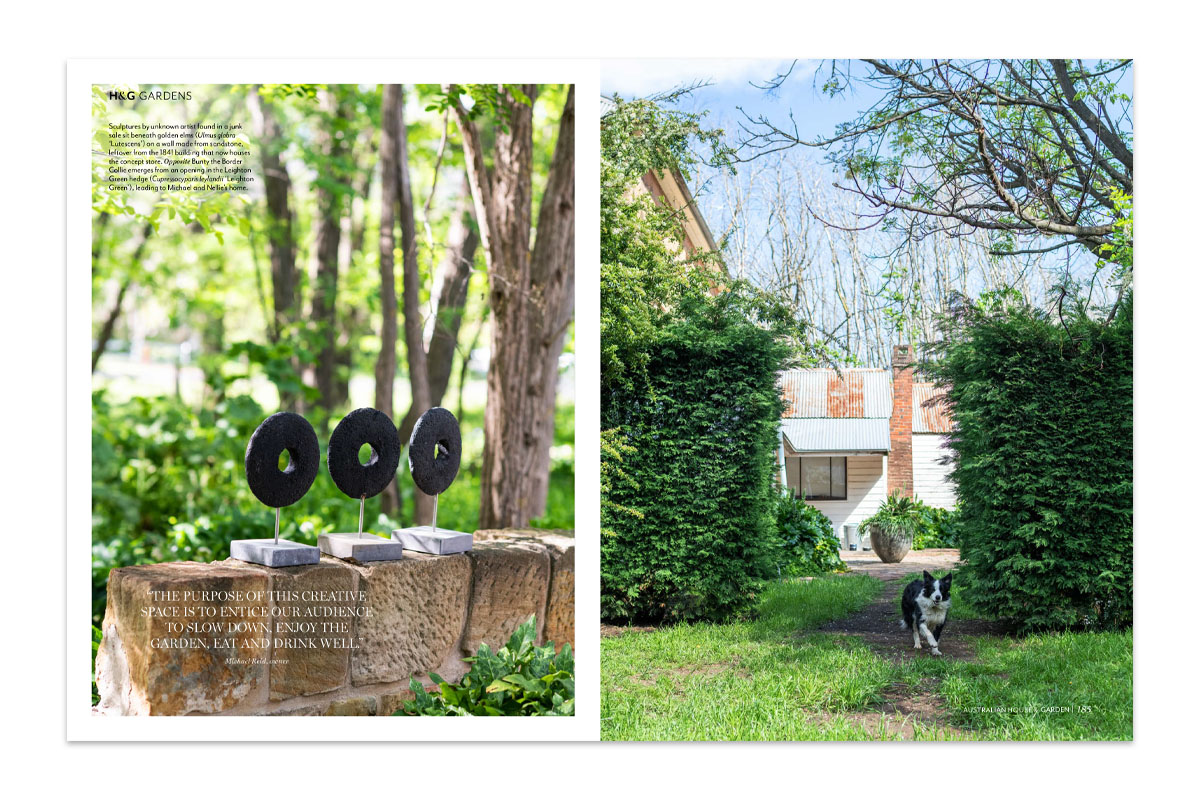
There is less room for subtlety and delicacy in a more public garden. Open gardens take a beating from people traffic, and as much as I enjoy leaf variations as the next person, the finer points of a whore-to-horticulturist can be lost on many. I still chuckle when I remember a member of the public asking me, “Why have the deciduous trees lost their leaves?”; I didn’t say, “Because they are deciduous, you fuckwit”; but I may have.
More public gardens must express a degree of visual clarity and overall impact simplicity than can be privileged in a private garden. Shade and beauty draw in my people and entice them to stay a while. The garden, in turn, compels my audience across and around my Murrurundi space, enticing them to settle and enjoy. These are all similar yet distinctly different propositions that a commercial garden designer anticipates, but a private space gardener may not.







Michael Reid OAM
- XXXVIII LA Story by Michael Reid OAM April 2024
- XLIX Paddy’s Cottage November 2025
- XLVIII Washington DC by Michael Reid OAM November 2025
- XLVII The Outdoor Fireplace at Murrurundi by Michael Reid OAM October 2025
- XLVI Amelia Zander of Zander & Co. July 2025
- XLV Marlie Draught Horse Stud by Michael Sharp June 2025
- XLIV Trump Engulfed the Fires by Michael Reid OAM February 2025
- XLIII Newcastle by Jason Mowen October 2024
- XLII The Business of Gardening by Michael Reid OAM September 2024
- XLI Carly Le Cerf by Sarah Hetherington August 2024
- XL Pecora Dairy by Michael Sharp July 2024
- XXXIX Joseph McGlennon by Michael Reid OAM May 2024
- XXXVII Julz Beresford by Michael Sharp March 2024
- XXXVI Sydney Contemporary by Jason Mowen February 2024
- XXXV The US of A by Michael Reid OAM December 2023
- XXXIV Scone Grammar School’s principal Paul Smart by Victoria Carey November 2023
- XXXIII AgQuip by Jason Mowen October 2023
- XXXII Tinagroo Stock Horse’s Jill Macintyre by Victoria Carey September 2023
- XXXI The Old Gundy School House by Victoria Carey August 2023
- XXX Annette English by Victoria Carey July 2023
- XXIX The Ghan by Jason Mowen June 2023
- XXVIII All in the family: The Arnotts May 2023
- XXVII A Capital Plan by Jason Mowen March 2023
- XXVI Mandy Archibald March 2023
- XXV Paul West February 2023
- XXIV The Other Newcastle by Jason Mowen January 2023
- XXIII Mount Woolooma Glasshouse at Belltrees December 2022
- XXII Murrurundi to Matino: with Jason Mowen November 2022
- XXI James Stokes October 2022
- XX Adelaide Bragg September 2022
- XIX Tamara Dean August 2022
- XVIII Going home: Angus Street July 2022
- XVII Belltrees Public School June 2022
- XVI A Road Trip on the New England Highway May 2022
- XV David and Jennifer Bettington: from horses to houses April 2022
- XIV Denise Faulkner: Art of the Garden March 2022
- XIII Childhood memories: Willa Arantz February 2022
- XII Riding ahead: Giddiup January 2022
- XI Ingrid Weir’s rural life December 2021
- X Life by design: William Zuccon November 2021
- IX Life on the land: The Whites October 2021
- VIII Goonoo Goonoo Station September 2021
- VII Murrurundi: a garden playground August 2021
- VI Pat’s Kitchen July 2021
- V A creative life: Charlotte Drake-Brockman June 2021
- IV Magpie Gin May 2021
- III The Cottage, Scone April 2021
- II At home with Jason Mowen March 2021
- I A town that performs February 2021











